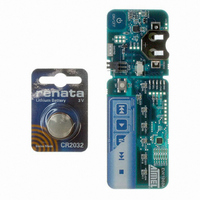EVK1060A Atmel, EVK1060A Datasheet

EVK1060A
Manufacturer Part Number
EVK1060A
Description
KIT EVAL FOR AT42QT1060-MMU
Manufacturer
Atmel
Series
Quantum, QTouch™r
Specifications of EVK1060A
Sensor Type
Touch, Capacitive
Sensing Range
1 Button/Key
Interface
I²C
Sensitivity
2mm ~ 5mm Pad Widths
Voltage - Supply
3V
Embedded
No
Utilized Ic / Part
AT42QT1060
Silicon Manufacturer
Atmel
Silicon Core Number
AT42QT1060-MMU
Kit Application Type
Sensing - Touch / Proximity
Application Sub Type
Capacitive Touch
Silicon Family Name
QT1060
Rohs Compliant
Yes
Lead Free Status / RoHS Status
Lead free / RoHS Compliant
Using the EVK1060A:
This kit is for the evaluation and development of applications using the AT42QT1060-MMU
('QT1060') 6 Channel QTouch
working in a battery powered 'Standalone' mode, but can connected to a PC and/or User application
by simple modifications/connections to the EVK1060A Evaluation Board.
The EVK1060A is configured with 6 capacitive keys (one as a 'Guard Channel'), 6 General Purpose
Inputs/Outputs (GPIO's) as Outputs (LED 0 - 5) and the seventh GPIO as an input channel (SW1).
Please refer to the QT1060 datasheet available at
•
•
•
•
•
•
•
•
5029:
•
•
•
AKS Feature:
On the EVK1060A, the AKS feature is a global setting for the 6 capacitive keys.
The AKS mode is changed by moving the 2-way link fitted to J1 as indicated.
• If AKS feature set to 'On' (link on Pins 1 and 2): When touching multiple keys, only the LED
• If set to 'Off' (link on Pins 2 and 3): When touching multiple keys, multiple LEDs will be lit.
SW1:
Pressing SW1 demonstrates the QT1060's 7th GPIO as an input. LED6 will illuminate when SW1 is
pressed.
associated with the key with the strongest signal is lit. The Guard Channel (K5) is configured to
give the strongest signal (large electrode and largest sense capacitor (C5) value)
Ensure the EVK1060A Evaluation Board has 6x clear feet fitted to underside of the PCB.
Insert the CR2032 3V battery provided into the battery holder on the EVK1060A.
Ensure that the battery has the correct orientation (negative (-) side to board) or the
EVK1060A will not work.
The LEDs will illuminate in a set sequence, then extinguish.
Touch and hold the ON/OFF symbol - Power LED will illuminate indicating power to the
QT1060. Remove touch from the ON/OFF symbol.
Touch any of the 5 key(s) (Rewind (K0), Play (K1), Pause (K2), Forward (K3), Stop (K4)) on
the EV1060A and the corresponding LED(s) will illuminate. (The number of LED(s)
illuminated will depend on the Adjacent Key Suppression
If the Guard Channel (K5 which surrounds K0 - K4) is touched, then LED5 will illuminate.
Touch and hold the ON/OFF symbol - The Power LED will extinguish to indicating power to
the QT1060 has been removed. Remove touch from the ON/OFF symbol.
The EVK1060A will power off after approximately 3 minutes of inactivity.
Provides On/Off QTouch
Determines whether connected to USB port/external I2C
Sets the QT1060 through I2C: Default values except:
Address
16
17
18
19
Value
15
15
15
15
TM
TM
Integrated Circuit (IC). In this example, the QT1060 is shown
button, including auto power-off
Address
20
21
22
23
Value
0x3F
12
8
1
www.atmel.com
Address
TM
25
26
27
30
(AKS
for full details.
TM
) feature setting at J1)
0x3F or 0x00
Value
0x1F
0
2
Guard Channel:
K5 Electrode surrounds K0 - K4 electrodes and LED5 is driven by the 5029 to show when touch is
detected on this channel. When AKS feature is on, this channel will can be used to indicate 'non-
desired' touches (e.g. when a product is in a pocket or against an ear) and can be used to advise
the User's host chip to ignore touches on other keys.
The width of the K5 electrode varies to show the Guard Channel effect. Compare the effect of
touching at the 2mm wide area to the effect at the 5mm wide area.
External Keyboard/Electrodes:
The EVK1060A can be connected to user electrodes, using pads adjacent to R0 – R5 and cutting
the associated 6 tracks (LK4 - LK9 on the schematic).
The EVK1060A can be divided, if required, (a cutting tool is required) to separate the QT1060A
circuit from the power and 5029 circuit.
Input/Output:
The EVK2160A can be connected to User applications through I2C, using the /CHG, SCL, SDA
pads.
The Plug-In USB card, Part Number 9206, which uses Atmel’s AT90USB64 IC, can be connected to
the connector J3. PC based software is available to further evaluate the QT1060 settings.
The seven GPIO’s are available at the pads on the top edge of the EVK1060A.
Sense Capacitors/Sensitivity:
C0 - C5 can be replaced with different value X7R capacitors to change the sensitivity of each of the
channels K0 - K5 respectively. Increasing the capacitor values will increase sensitivity and
decreasing the capacitor value will decrease the sensitivity. (All flux residues should be removed
after component replacement.)
The sensitivity of all channels will increase if any pad/component connected to ground is touched.
Compare touching a key when the EVK1060A is on a desk, to when the EVK1060A is picked up
and held at the GND PAD.
Power Supply:
An external power supply can be used instead of the supplied battery, but ensure that Schottky
diodes are fitted to D1 and D2 to prevent cross powering of USB and battery sources.
It is advised to remove the battery when using an external power supply.
Touch Technology Division
1 Mitchell Point
Ensign Way, Hamble
Southampton SO31 4RF
United Kingdom
Tel: +44 (0)23 8056 5600
Fax:+44 (0)23 8045 3939
2x Sample AT42QT1060-MMU ICs
1x CR2032 Battery, 3V, 235mAh
Packed by:
3mm
1x EVK1060A Assembly
2mm
EVK1060A Kit Contents:
1x EVK1060A User Guide
4.5mm
Copyright © 2008 QRG Ltd.
All rights reserved
Patented and patents pending
www.atmel.com
qprox.support@atmel.com
REV 100.0908
Dated:
TM
5mm

